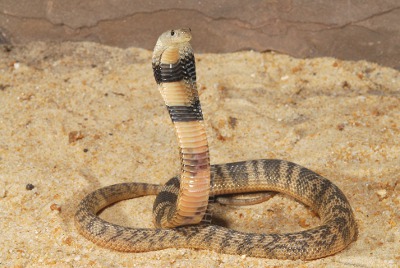Central Asian Cobra Snake
Category: Snakes

Facts about Central Asian Cobra snake. "Scientific name for Central Asian Cobra snake is Naja oxiana". Central Asian Cobra snake is a Naja type of poisonous snake that comes from the Elapidae family. The Central Asian Cobra snakes are native to Central Asia, and they are called by other names, such as the Caspian cobra or Oxus cobra. The Central Asian Cobra snake is considered the most poisonous snake in the world. The Central Asian Cobra snakes are largely found in the Transcaspian Region, and they also found in Uzbekistan, Turkmenistan, Kyrgyzstan, Tadzhikistan, east and north Afghanistan, from the Kashmir area east to the Himachal Pradesh state in India. Usually, the Central Asian Cobra prefers to live in areas, such as rocky or stony, arid and semiarid, scrub or shrub covered foothills at a maximum height of 9,800 feet (2987 meters) above sea level.
Features of Central Asian Cobra snakes
The Central Asian Cobra is an average to large size snake that attains a maximum body length of 3 5/16 feet (1 meter)when fully grown. The Central Asian Cobra snakes have a well-built body, with elongated cervical ribs that is capable of expansion to structure a cover. The Central Asian Cobra snake have a dorsoventrally compressed and subcylindrical posteriorly body.
The head of the Central Asian Cobra snake is elliptical in shape, which is depressed, and somewhat distinct from the neck, with a small, rounded nose and big nostrils. The eyes of this snake are average in size with circular pupils. The Central Asian Cobra snake have smooth, powerfully oblique dorsal scales, with the external two or three scale chains bigger than the remainder. The Central Asian Cobra snake contains 23 to 27 scale rows about the hood, 19 to 23 scales just previous to the middle part of the body, 191 to 210 ventral scales, and 57 to 71 paired subcaudals, but cuneates are habitually absent.
Juvenile Central Asian Cobra snakes are inclined to be light, with a dull appearance. They boast visible light and dark cross-bands of roughly the same width around their body. Adult Central Asian Cobra snakes of this variety have an entire light to coffee brown or yellow color body. A few of the Central Asian Cobra snakes keep traces of young banding, particularly the primary few dark ventral bands. This snake variety has no covering mark and side throat spots.
Diet of Central Asian Cobra snakes
The Central Asian Cobra chiefly feeds on tiny creatures, birds and amphibians during early morning and the evening. The Central Asian Cobra snake will also feed on toads, rodents and frogs, rarely fish, and the eggs of birds.
Behavior of Central Asian Cobra snakes
Generally, the Central Asian Cobra snake is bad-tempered and violent. Even though these snakes will keep away from humans as much as possible, they will turn out to be severely aggressive when cornered or threatened. Even juvenile snakes are inclined to be extremely aggressive. When provoked and cornered, the Central Asian Cobra snake will spread its cover, hiss, swing from side to side and hit frequently, but it is not a spitter. This earthly snake variety is mostly diurnal, but it may be nocturnal and crepuscular in a few parts of its collection during the months of July and August, which are hotter. The Central Asian Cobra is a good swimmer and a good climber. It is habitually found in water and not often found excessively far away from it. These are fast-moving and nimble snakes, and the Central Asian Cobra snake live in the gaps of river banks or trees.
The average lifespan of the Central Asian Cobra snake ranges from 20 years to 30 years.

 Back To Category Snakes
Back To Category Snakes